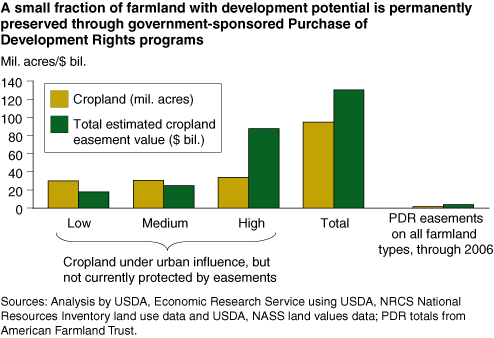Farmland Preservation Programs: Another Tool for Managing Urban Growth?
- by Cynthia Nickerson and Daniel Hellerstein
- 4/1/2007
On average, 2.2 million acres of farmland per year were converted to urban uses between 1992 and 2001. While this annual rate represents about a tenth of a percent of the Nation’s farmland, conversion rates are much higher near rapidly growing urban areas. For a variety of reasons, including the amenities and environmental services provided by farmed landscapes, such losses are a public concern, demonstrated by the growing budgets and legislative support for farmland preservation programs and policies. Yet, the long-term impact of permanent farmland preservation on development trends remains an open question.
Every State has enacted measures that help protect farmland, but most measures do not preserve farmland permanently. Among the most popular approaches are laws, such as rural residential zoning laws and right-to-farm laws, and voluntary programs, such as preferential property tax programs. Studies show that the impacts of these types of voluntary programs and regulatory approaches tend to slow the rate at which farmland gets converted rather than provide permanent protection.
An alternative approach, Purchase of Development Rights (PDR) programs, is increasingly popular, despite its higher cost. These programs place permanent or long-term restrictions on development of voluntarily enrolled parcels. Through 2006, State and local governments have purchased development rights on over 1.7 million acres of farmland through PDR programs at a cost of $4 billion. This includes contributions from USDA’s Federal Farm and Ranch Lands Protection Program (FRPP). FRPP’s funding was dramatically expanded in the 2002 farm bill, and continued expansion of the program is likely to be revisited with the next farm bill.
Despite these growing outlays, the amount of land preserved through PDR programs represents less than 2 percent of cropland that ERS estimates to be subject to some degree of development pressure. According to ERS estimates, the total cost of preserving all such cropland today could be as much as $130 billion.
Little is known about the effects of PDR programs on development patterns in the long run. If demand for developable land remains sufficiently strong and transportation infrastructure keeps commuting costs from rising disproportionately, PDR programs may simply have the effect of shifting development to adjacent unprotected land rather than stopping farmland conversions from happening. If this occurs, it may be more realistic to view even PDR programs as tools to help local jurisdictions manage growth and guide development away from farmland with desirable characteristics, rather than as a panacea for stopping urban sprawl.
This article is drawn from:
- Hellerstein, D., Nickerson, C., Cooper, J., Feather, P., Gadsby, D., Mullarkey, D., Tegene, A. & Barnard, C. (2005). Farmland Protection: The Role of Public Preferences for Rural Amenities. U.S. Department of Agriculture, Economic Research Service. AER-815.


